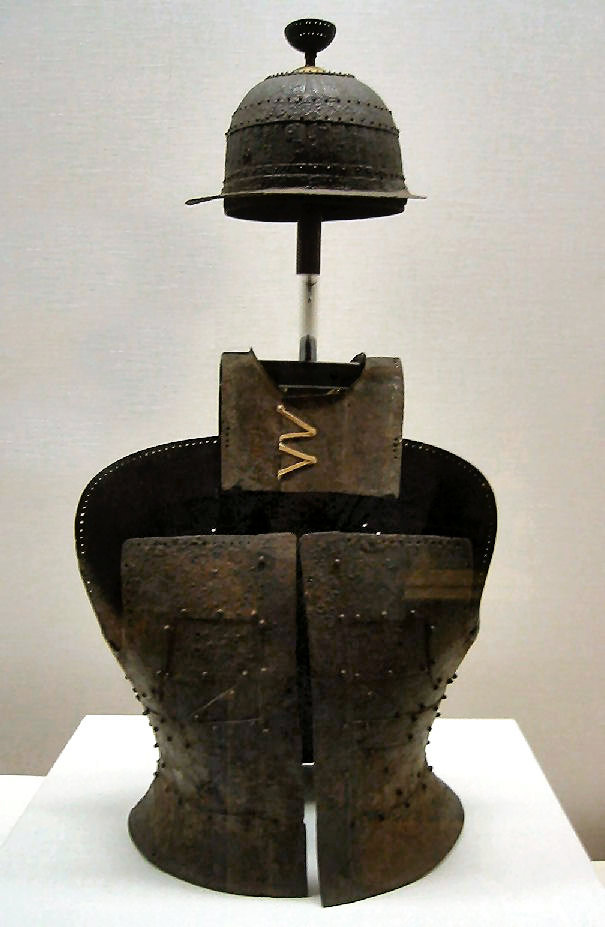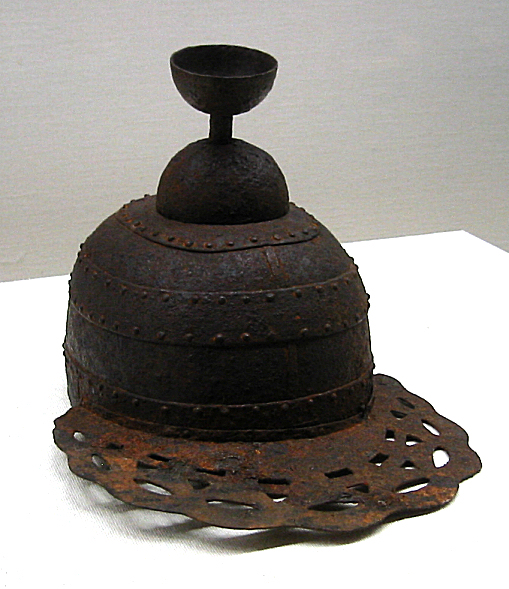Tankō on:
[Wikipedia]
[Google]
[Amazon]
 Tankō ( Jap. "short armor") is a form of
Tankō ( Jap. "short armor") is a form of
 The ''tankō'' is the first uniquely definable type of Japanese armor. Other types that were used earlier such as ''Jòdai no Katchù'' (ancient armor, as described by armor historian Suenaga Masao) have been mentioned, but are not entirely verifiable.
The ''tankō'' was made of sheet iron and
The ''tankō'' is the first uniquely definable type of Japanese armor. Other types that were used earlier such as ''Jòdai no Katchù'' (ancient armor, as described by armor historian Suenaga Masao) have been mentioned, but are not entirely verifiable.
The ''tankō'' was made of sheet iron and
 The helmets (''mabisashi'') worn with the ''tankō'' armor type are known in two versions. The first type ( jap. Kondu Maruhachi) consisted of sheets of overlapping iron similar to the ''tankō'' chest piece). Lamella pieces were riveted to horizontally lying bands to create a dome shape for the helmet. A short eye shield was attached to the front, which was often pierced with holes. A small hump with a fixing pin for a crest lied at the top of the helmet's dome.
The helmets (''mabisashi'') worn with the ''tankō'' armor type are known in two versions. The first type ( jap. Kondu Maruhachi) consisted of sheets of overlapping iron similar to the ''tankō'' chest piece). Lamella pieces were riveted to horizontally lying bands to create a dome shape for the helmet. A short eye shield was attached to the front, which was often pierced with holes. A small hump with a fixing pin for a crest lied at the top of the helmet's dome.
 The second type was created differently, with horizontal and vertical bands throughout the helm's dome. The eye shield and attachment for the crest were much larger. The attachment also included a shell-like form that served to further fasten and accentuate the crest.
The second type was created differently, with horizontal and vertical bands throughout the helm's dome. The eye shield and attachment for the crest were much larger. The attachment also included a shell-like form that served to further fasten and accentuate the crest.
Reconstruction of a Tankō helm
Kofun Jidai Tankō from Flickr
Kofun Jidai Tankō in the Tokyo National Museum from Flickr
Kofun helm in Metropolitan Museum, New York
Japanese armour
 Tankō ( Jap. "short armor") is a form of
Tankō ( Jap. "short armor") is a form of Japanese armor
Scholars agree that Japanese armour first appeared in the 4th century, with the discovery of the cuirass and basic helmets in graves. During the ''Heian period'' (794-1185), the unique Japanese samurai armour '' ō-yoroi'' and ''dō-maru'' appe ...
that was common in the Kofun period.
Tankō
 The ''tankō'' is the first uniquely definable type of Japanese armor. Other types that were used earlier such as ''Jòdai no Katchù'' (ancient armor, as described by armor historian Suenaga Masao) have been mentioned, but are not entirely verifiable.
The ''tankō'' was made of sheet iron and
The ''tankō'' is the first uniquely definable type of Japanese armor. Other types that were used earlier such as ''Jòdai no Katchù'' (ancient armor, as described by armor historian Suenaga Masao) have been mentioned, but are not entirely verifiable.
The ''tankō'' was made of sheet iron and tanned leather
Tanning may refer to:
*Tanning (leather), treating animal skins to produce leather
*Sun tanning, using the sun to darken pale skin
**Indoor tanning, the use of artificial light in place of the sun
**Sunless tanning, application of a stain or dye t ...
, laced at the hips to conform to the wearer's body. The leather served as a support for the iron sheets, and as a protective lining
Lining may refer to:
* Lining (sewing), the process of inserting an inner layer of fabric, fur, or other material
* Lining of paintings, the process of restoration paintings by attaching a new canvas to the back of the existing one
* Brake linin ...
meant to prevent damage to the wearer's clothing and skin. The iron sheets were formed into strips that were rivet
A rivet is a permanent mechanical fastener. Before being installed, a rivet consists of a smooth cylindrical shaft with a head on one end. The end opposite to the head is called the ''tail''. On installation, the rivet is placed in a punched ...
ed side-by-side or overlapping. The carapace was built higher than the breastplate in order to provide protection for the neck. The front side had an opening that could be closed once the armor was put on. The armor was attached to the body via fabric bands that ran over the shoulders.
Keikō
Another Japanese armor type from the Kofun period, the ''keikō'' ("hanging armor"). The type was also used in Japan as armor for mounted forces as the use of cavalry in warfare increased in importance.William Wayne Farris: ''Sacred texts and buried treasures.'' 1998, S. 76. The difference between the ''tankō'' and ''keikō'' lies in the upper chest area of the armor, which in the ''keikō'' variant included a protective sheath of iron bands. The lower portion of both types consisted of overlapping iron lammellae. The use of leather underpinnings was also used by both forms. The bands were fixed together through riveting or the use of leather straps.Helmet
 The helmets (''mabisashi'') worn with the ''tankō'' armor type are known in two versions. The first type ( jap. Kondu Maruhachi) consisted of sheets of overlapping iron similar to the ''tankō'' chest piece). Lamella pieces were riveted to horizontally lying bands to create a dome shape for the helmet. A short eye shield was attached to the front, which was often pierced with holes. A small hump with a fixing pin for a crest lied at the top of the helmet's dome.
The helmets (''mabisashi'') worn with the ''tankō'' armor type are known in two versions. The first type ( jap. Kondu Maruhachi) consisted of sheets of overlapping iron similar to the ''tankō'' chest piece). Lamella pieces were riveted to horizontally lying bands to create a dome shape for the helmet. A short eye shield was attached to the front, which was often pierced with holes. A small hump with a fixing pin for a crest lied at the top of the helmet's dome.
 The second type was created differently, with horizontal and vertical bands throughout the helm's dome. The eye shield and attachment for the crest were much larger. The attachment also included a shell-like form that served to further fasten and accentuate the crest.
The second type was created differently, with horizontal and vertical bands throughout the helm's dome. The eye shield and attachment for the crest were much larger. The attachment also included a shell-like form that served to further fasten and accentuate the crest.
Shield
The shield worn with this type of armor was made of sheet iron fixed to a wooden base. The shield's components were fixed to each other and the shield's body through the use of riveting. The exterior has a slightly convex shape, and was decorated with triangular and linear patterns.Catharina Blomberg: ''The heart of the warrior. Origins and religious background of the Samurai system in feudal Japan.'' Japan Library, Sandgate 1994, , S. 1.Naming Origins
The names ''tankō'' and ''keikō'' are not historical, but archaeological in origin. In the sacrificial book ofTōdai-ji
is a Buddhist temple complex that was once one of the powerful Seven Great Temples, located in the city of Nara, Japan. Though it was originally founded in the year 738 CE, Tōdai-ji was not opened until the year 752 CE. The temple has undergo ...
from 756 ''tankō'' and ''keikō'' are listed as gifts. These terms were then assigned to varying types of excavated armor.
Literature
* 講談社, ''Japan. An illustrated encyclopedia.'' Band 1: ''A – L.'' Kodansha, Tokio 1993, . * William Wayne Farris: ''Sacred texts and buried treasures. Issues in the historical archaeology of ancient Japan.'' University of Hawai'i Press, Honolulu HI 1998, . *Karl Friday
Karl F. Friday (born 1957) is an American Japanologist.
Friday earned a bachelor's degree in Japanese at the University of Kansas in 1979, followed by a master's degree in East Asian languages and culture from the same institution in 1983. He th ...
: ''Samurai, warfare and the state in early medieval Japan.'' Routledge, New York NY u. a. 2004, , S. 186, 187.
* Thomas Louis, Tommy Ito: ''Samurai. The Code of the Warrior.'' Sterling Publishing Company, New York NY 2008, .
References
External links
{{commons category, TankoReconstruction of a Tankō helm
Kofun Jidai Tankō from Flickr
Kofun Jidai Tankō in the Tokyo National Museum from Flickr
Kofun helm in Metropolitan Museum, New York
Japanese armour